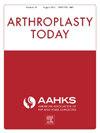Trends in Outpatient Primary Total Hip and Knee Replacement From the Hospital Outpatient Department and Ambulatory Surgery Center Settings in New York State
IF 2.1
Q3 ORTHOPEDICS
引用次数: 0
Abstract
Background
While ambulatory surgery centers (ASCs) are increasingly used for outpatient total hip replacement and total knee replacement, collectively total joint replacement (TJR), due to association with similar or lower rates of postsurgical complications, readmissions, and reduced cost, ASC utilization trends have not been well studied. The purpose of this study was to analyze patients undergoing inpatient and outpatient TJR in New York State to identify 1) temporal site-of-service trends for inpatient and outpatient TJR and 2) characteristics of patients undergoing outpatient TJR in hospital outpatient departments (HOPDs) and ASC versus inpatient.
Methods
New York Statewide Planning and Research Cooperative System database was used to identify TJR patients in each procedure setting (hospital inpatient department, HOPD, and ASC) from 2011 to 2021. We report outpatient TJR trends from 2011 to 2021 and use a multivariable generalized linear mixed model to determine characteristics of patients who have greater odds of TJR in the HOPD or ASC setting.
Results
Outpatient TJR volume substantially increased over time. TJR patients in ASC compared to hospital inpatient department were younger and privately insured and had fewer comorbidities. Older, non-Hispanic Black, Hispanic patients with more medical comorbidities and patients with Medicare, Medicaid, or workers’ compensation exhibited decreased odds of TJR in both HOPDs and ASCs. Patients residing in rural areas were more likely to undergo surgery in an ASC relative to the in-patient setting for total knee replacement only.
Conclusions
Patients who are older, are non-White, have increased comorbidity burdens, or are publicly insured were less likely to undergo outpatient TJR in both the HOPD and ASC settings.
来自纽约州医院门诊部和门诊手术中心的门诊原发性全髋关节和膝关节置换术的趋势
背景虽然门诊手术中心(ASCs)越来越多地用于门诊全髋关节置换术和全膝关节置换术,总的来说,全关节置换术(TJR)由于与类似或更低的术后并发症、再入院率和降低的成本相关,但ASC的使用趋势尚未得到很好的研究。本研究的目的是分析纽约州接受住院和门诊TJR的患者,以确定1)住院和门诊TJR的时间服务地点趋势;2)医院门诊部(hopd)和ASC接受门诊TJR的患者与住院患者的特征。方法采用纽约州规划与研究合作系统数据库,对2011 - 2021年各程序设置(医院住院部、HOPD和ASC)的TJR患者进行识别。我们报告了2011年至2021年的门诊TJR趋势,并使用多变量广义线性混合模型来确定HOPD或ASC环境中TJR几率较大的患者的特征。结果随着时间的推移,门诊TJR数量显著增加。与医院住院部相比,ASC的TJR患者更年轻,私人保险,合并症更少。老年、非西班牙裔黑人、有更多医疗合并症的西班牙裔患者以及接受医疗保险、医疗补助或工人补偿的患者在hopd和ASCs中均表现出TJR的发生率降低。居住在农村地区的患者更有可能在ASC接受手术,而不是住院的全膝关节置换术。结论:年龄较大、非白人、合并症负担增加或有公共保险的患者在HOPD和ASC环境中接受门诊TJR的可能性较小。
本文章由计算机程序翻译,如有差异,请以英文原文为准。
求助全文
约1分钟内获得全文
求助全文
来源期刊

Arthroplasty Today
Medicine-Surgery
CiteScore
2.90
自引率
0.00%
发文量
258
审稿时长
40 weeks
期刊介绍:
Arthroplasty Today is a companion journal to the Journal of Arthroplasty. The journal Arthroplasty Today brings together the clinical and scientific foundations for joint replacement of the hip and knee in an open-access, online format. Arthroplasty Today solicits manuscripts of the highest quality from all areas of scientific endeavor that relate to joint replacement or the treatment of its complications, including those dealing with patient outcomes, economic and policy issues, prosthetic design, biomechanics, biomaterials, and biologic response to arthroplasty. The journal focuses on case reports. It is the purpose of Arthroplasty Today to present material to practicing orthopaedic surgeons that will keep them abreast of developments in the field, prove useful in the care of patients, and aid in understanding the scientific foundation of this subspecialty area of joint replacement. The international members of the Editorial Board provide a worldwide perspective for the journal''s area of interest. Their participation ensures that each issue of Arthroplasty Today provides the reader with timely, peer-reviewed articles of the highest quality.
 求助内容:
求助内容: 应助结果提醒方式:
应助结果提醒方式:


